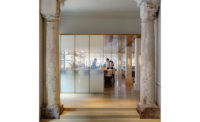3SIX0 Architecture & Design
Chris Bardt and Kyna Leski describe their work process as “material reasoning,” a hands-on way of designing by doing. Bardt and Leski, partners in the Providence firm 3SIX0, both teach at the Rhode Island School of Design (RISD) and explore ideas by making models—wire frame, paper, cardboard, wood, you name it—and mock-ups at various scales. Deeply involved with one of the only architecture programs in the U.S. set within an art and design school, rather than an academic or research institution, Bardt and Leski bring a strong materials sensibility to projects such as Stix, a 1,500-square-foot restaurant and club in the Back Bay area of Boston.
The concept behind Stix was to serve food on skewers (“sticks”) in a casual setting where guests might strike up conversations with strangers sitting nearby. The business model envisioned renting out the restaurant for private and corporate functions during which most guests would eat and drink standing up. In other words, the place had to work for both sit-down dining and cocktail parties—a tough design challenge for the architects.
In 2002, Bardt and Leski designed the restaurant 33 [RECORD, December 2002, page 118], which sits next door to Stix and has the same owners—Greg Den Herder and Igor Blatnik. While 33 has been a big success, the architects now feel they packed too many design ideas into one place. For Stix, they decided to develop one strong concept and keep everything else simple. At first, they explored the idea of creating a bar featuring a series of fingerlike extensions where customers could sit and talk to people at adjacent projections. They rejected this scheme, though, because it used too much space and didn’t provide enough flexibility. Eventually, they developed the idea of a continuous “coil” wrapping around the floor, ceiling, and one wall—an element that would hold everything together visually and programmatically. However, instead of curving around the 1,100-square-foot main space on the first floor, this coil would zig and zag as a sequence of straight-edged parallelograms made of rift-sawn oak. More than just a cool graphic device, this element would house dining tables that could be folded up and docked on the wall, freeing up floor space when the restaurant switched to cocktail-party mode.
3SIX0 based the restaurant’s geometry on parallelograms, says Bardt, because they use space most efficiently. “It’s the same idea as parallel parking,” explains Leski. “You can park more cars when they’re set at an angle.” Originally, the architects wanted to make the tables fit flush when upright, creating a uniform, flat wall surface. But then they discovered the existing brick wall projects out at one point several inches, which made the flush-wall scheme a lot more expensive to build. So they floated the oak coil and its fold-up tables about 10 inches off the wall and let the existing red brick serve as a contrasting backdrop to the newly inserted wood surfaces. And if diners look carefully, they can see how all the pieces fit together, something that would have been more difficult to understand if everything were flush.
PeopleOwner: Helvetica Group Architect: Personnel in architect's firm who should receive special credit: Engineer(s): TEC Inc., Lawrence, MA Consultant(s): General contractor: Cafco Construction Management, Boston, MA Photographer(s): John Horner, Boston, MA, 617-625-9025 CAD system, project management, or other software used: AutoCad |
ProductsExterior cladding: Existing Roofing: Existing Windows: Existing Glazing: Existing Doors: Hardware: Cabinet hardware: HAFELE Interior finishes: Suspension grid: Armstrong (back of house, kitchen and service areas) Cabinetwork and custom woodwork: Butler Architectural Woodwork, Quarter sawn white oak veneer on fire rated mdf Paints and stains: Benjamin Moore Paneling: Butler Architectural Woodwork,Quarter sawn white oak veneer on fire rated mdf Plastic laminate: Sensitile Systems Light Transmitting Concrete Countertop Special surfacing: LUMAsite transparent plastic (back bar millwork) Floor and wall tile: main dining/bar space, Expanko Cork Flooring, medium and dark finishes. Ground floor bathroom, Tau Ceramica Corten Porcelain floor and wall tile Furnishings: Fixed seating: Butler Architectural Woodwork Tables: Butler Architectural Woodwork Upholstery: Thomas H. Little Upholstery Co. Lighting: Downlights: JUNO INDY 4" 50W PAR 30 Controls: Colorkinetics Plumbing:
|








Post a comment to this article
Report Abusive Comment